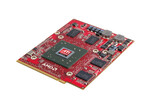ATI Mobility Radeon HD 3850

The AMD ATI Mobility Radeon HD 3850 is a slower clocked desktop HD 3850 and manufactured in 55 nm. It supports DirectX 10.1 in hardware and also features the Avivo HD video engine to help the CPU decode videos. The card is intended to be used in large laptops.
The performance of the graphics card is between the GeForce 8700M GT and the 8800M GTS. The ATI Mobility Radeon HD 4650 of the successor generation performed similar but with a much lower power consumption. Therefore, the performance should be sufficient for DirectX 9 games in medium to high details (see games list beyond).
The RV670 chip has 64 5-dimensional unified shaders with 16 ROPs, 16 TMUs, and 32 TAUs.
The Avivo HD video engine helps the cpu in decoding HD videos (MPEG-2, H.264, VC-1). The HD 3850 houses the UVD+ (Unified Video Decoder) that is capable of decoding MPEG-2, H.265/AVC, and VC-1 nearly fully. The UVD2 in the HD 4000 generation is capable of full bitstream decoding and two video streams can be decoded at once (which UVD+ can not).
Compared to desktop graphics cards, the HD 3850 is similar to the Radeon HD 3850 but features a much lower clock speed, leading to a worse performance.
The power consumption of the HD 3800 series lies between 35-55 Watt.
Mobility Radeon HD 3800 Series
| |||||||
| Codename | M88 | ||||||
| Architecture | RV6xx | ||||||
| Pipelines | 320 - unified | ||||||
| Core Speed | 580 MHz | ||||||
| Memory Speed | 750 MHz | ||||||
| Memory Bus Width | 256 Bit | ||||||
| Memory Type | GDDR3 | ||||||
| Shared Memory | no | ||||||
| API | DirectX 10.1, Shader 4.1 | ||||||
| Power Consumption | 55 Watt | ||||||
| Transistor Count | 666 Million | ||||||
| technology | 55 nm | ||||||
| Features | HDMI, Dual-Link DVI (wenn vom Hersteller verbaut), HDCP, PCI-Express 2.0 | ||||||
| Notebook Size | large | ||||||
| Date of Announcement | 01.12.2007 | ||||||
| Information | 55nm, Display Port with external transmitter | ||||||
| Link to Manufacturer Page | ati.amd.com | ||||||
Benchmarks
3DM Vant. Perf. total +
* Smaller numbers mean a higher performance
Game Benchmarks
The following benchmarks stem from our benchmarks of review laptops. The performance depends on the used graphics memory, clock rate, processor, system settings, drivers, and operating systems. So the results don't have to be representative for all laptops with this GPU. For detailed information on the benchmark results, click on the fps number.
| low | med. | high | ultra | QHD | 4K | |
|---|---|---|---|---|---|---|
| Crysis - GPU Benchmark | 32.1 | 27.01 | 21.09 | |||
| Crysis - CPU Benchmark | 37.11 | 23.77 | 19.66 | |||
| F.E.A.R. | 144 | 22 | 21 | |||
| Quake 3 Arena - Timedemo | 343.8 | |||||
| low | med. | high | ultra | QHD | 4K | < 30 fps < 60 fps < 120 fps ≥ 120 fps | 2 1 | 3 | 3 1 | | | |
For more games that might be playable and a list of all games and graphics cards visit our Gaming List
Gaming Performance
This benchmarks were conducted with an AMD Puma platform (with a Turion 64 Ultra at 2.4 GHz). Therefore, a fast Core 2 Duo should perform better.
Crysis: 1024x768, medium: 24 fps -> barely playable
World in Conflict: 1024x768, Medium: 30 fps -> playable
Medal of Honor: Airborne: 1024x768, High: 35 fps -> playable
Notebook reviews with ATI Mobility Radeon HD 3850 graphics card
MSI Megabook GT735: AMD Turion X2 Ultra ZM-82, 17.00", 3.7 kg
External Review » MSI Megabook GT735
















